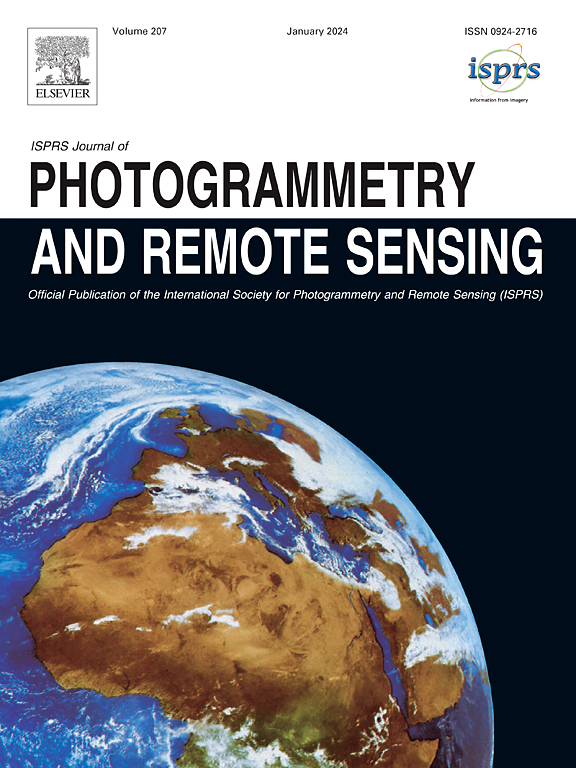Solar cities: Multiple-reflection within urban canyons
IF 10.6
1区 地球科学
Q1 GEOGRAPHY, PHYSICAL
ISPRS Journal of Photogrammetry and Remote Sensing
Pub Date : 2025-06-15
DOI:10.1016/j.isprsjprs.2025.05.031
引用次数: 0
Abstract
Solar photovoltaic (PV) harvesting is a significant energy resource leading to the rapid expansion of renewable energy. To facilitate decision-making regarding the optimal location and appropriate time for harvesting solar energy, the precise estimation of solar potential distribution in a city especially in 3D context is essential. However, using constant values to represent the urban vertical façades in a city and/or ignoring the indirect components under the estimation of received irradiation have been adopting in the current research, which may lead to inaccuracies in final results particular in complex urban environment. In this work, we propose a methodology to estimate the solar potential accurately by incorporating the façade albedo using street view images, as well as considering multiple reflection in urban canyon. Furthermore, this method is further integrated in the proposed evaluation framework to assess the impact of urban façade albedo on solar potential distribution. Compared to existing methods, the proposed framework first discusses and analyzes the importance of façade albedo and evaluates its impact quantitatively. The experimental results show that the discrepancies in albedo significantly affect the overall solar potential by 8.0% to 9.1%. If multiple reflections under urban canyon are disregarded, the impact can reach 11.9% to 17.8%.
太阳能城市:城市峡谷内的多重反射
太阳能光伏发电(PV)是一种重要的能源,导致可再生能源的迅速发展。为了方便在最佳位置和适当的时间收集太阳能的决策,精确估计太阳能在城市中的潜在分布是至关重要的,特别是在3D背景下。然而,目前的研究大多采用恒定值来表示城市的垂直辐射,或忽略接收辐射估算下的间接分量,这可能导致最终结果不准确,特别是在复杂的城市环境中。在这项工作中,我们提出了一种利用街景图像结合farade反照率并考虑城市峡谷多重反射的方法来准确估计太阳能潜力。此外,将该方法进一步整合到所提出的评价框架中,评价城市地表反照率对太阳势分布的影响。与现有方法相比,本文提出的框架首先讨论和分析了farade反照率的重要性,并对其影响进行了定量评价。实验结果表明,反照率差异对总太阳能势的影响显著,影响幅度为8.0% ~ 9.1%。如果忽略城市峡谷下的多重反射,影响可达11.9% ~ 17.8%。
本文章由计算机程序翻译,如有差异,请以英文原文为准。
求助全文
约1分钟内获得全文
求助全文
来源期刊

ISPRS Journal of Photogrammetry and Remote Sensing
工程技术-成像科学与照相技术
CiteScore
21.00
自引率
6.30%
发文量
273
审稿时长
40 days
期刊介绍:
The ISPRS Journal of Photogrammetry and Remote Sensing (P&RS) serves as the official journal of the International Society for Photogrammetry and Remote Sensing (ISPRS). It acts as a platform for scientists and professionals worldwide who are involved in various disciplines that utilize photogrammetry, remote sensing, spatial information systems, computer vision, and related fields. The journal aims to facilitate communication and dissemination of advancements in these disciplines, while also acting as a comprehensive source of reference and archive.
P&RS endeavors to publish high-quality, peer-reviewed research papers that are preferably original and have not been published before. These papers can cover scientific/research, technological development, or application/practical aspects. Additionally, the journal welcomes papers that are based on presentations from ISPRS meetings, as long as they are considered significant contributions to the aforementioned fields.
In particular, P&RS encourages the submission of papers that are of broad scientific interest, showcase innovative applications (especially in emerging fields), have an interdisciplinary focus, discuss topics that have received limited attention in P&RS or related journals, or explore new directions in scientific or professional realms. It is preferred that theoretical papers include practical applications, while papers focusing on systems and applications should include a theoretical background.
 求助内容:
求助内容: 应助结果提醒方式:
应助结果提醒方式:


